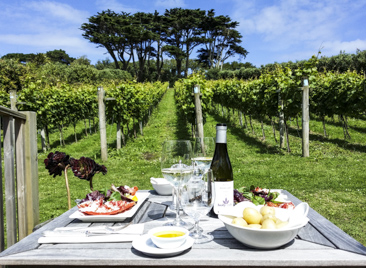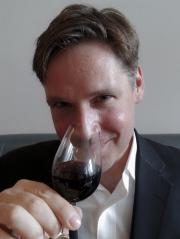Star Chateau
POSTED ON 28/09/2015Thwarted by two false starts, the first for storms, the second for rail strikes, it was finally chocks away as the Islander lifted off like a Mountain Banshee from Land’s End airport. Within 15 minutes, it deposited its eight passengers on St Mary’s in the Scilly Isles. Quarter of an hour later, I was standing in England’s most southerly vineyard, glass of Holy Vale Pinot Noir Rosé in hand.
 Lobster in Holy Vale
Lobster in Holy Vale
Life in a Bubble
POSTED ON 19/09/2015Being a champagne expert doesn’t make you a Stephen Fry, as Tom Stevenson and co-judges, Essi Avellan MW and Tony Jordan, would be the first to admit. Announcing the 2015 Champagne and Sparkling Wine Awards at the Vintner’s Hall, Stevenson’s delivery was accompanied by a squeaky voiceover whose digital unmentionables were apparently being squeezed. The lack of slickness was compensated by plenty of bling in the bottle and an enlightening analysis of the world of bubbles.
Bargain Basement or Trap Door?
POSTED ON 12/09/2015Do you scan the aisles of supermarkets desperately seeking only products whose dangler, glorifier, wobbler or necker promises a BOGOF, three for two or half price deal? Or do you assiduously shun such promotions as dirty tricks, sorry marketing gimmicks, aimed at luring the gullible and my mother into impulse buys? At least Aldi and Lidl, as this column has pointed out, do what they say on the tin because their no-frills prices are an honest substitute for a potentially dubious promotion.
Every Lidl Helps
POSTED ON 05/09/2015Have you bought any wine recently from Schwarz Lebensmittel-Sortimentsgroßhandlung? Didn’t think so. You may have bought a wine from Lidl though, which is the surname Dieter Schwarz acquired for 1,000 German Marks from Ludwig Lidl because the former name was too long, and Schwarzmarkt, or Black Market, probably wasn't a great idea for a retailer.
The Wine Mosquito
POSTED ON 22/08/2015 Greg Lambrecht
Greg Lambrecht
Drink less but better is a laudable enough aim but hard to achieve once the genie is out of the bottle. How different if you could have just one glass, two perhaps, half a bottle even, of a fine wine without having to open the bottle. A fanciful idea? It was until an American medical inventor called Greg Lambrecht decided when his wife was pregnant that he was going to find a way of drinking a glass without actually opening the bottle.
Summer’s Last Hurrah
POSTED ON 15/08/2015It is still summer, isn’t it? In the South of France mid-August is traditionally a time for thunderstorms and torrential downpours, bringing in their wake the first wistful chill of autumnal air. Here, it’s not just the changeable weather that’s baffling on a surreal Saturday when Rooney & Co. are performing before the first ball of the fifth Ashes Test is bowled. But if my glass is half full today, I want it topped up with appetisingly dry whites to prolong the al fresco moments before the nights draw in.
By The Book: Oz Clarke's 100 Bottles
POSTED ON 08/08/2015As a communicator who’s spent a lifetime making wine entertaining, Oz Clarke takes us on an unapologetically personal romp through many of the most significant moments in wine in The History of Wine in 100 Bottles (£20, Pavilion). Every bottle drained tells stories of ‘the politics, the science, the empire-building and the wars, the lucky mistakes, the brilliant guesses, the leaps in the dark and the human frailties that have created our world of wine’.
Essen and Drink’n at Aldi
POSTED ON 01/08/2015I recently visited Aldi’s Midlands HQ to find out more about the Aldi story from head wine honcho Mike James, a thoughtful doctor of philosophy who topped Off Licence News’ Top 100 list of the UK’s most influential wine people. First we called into the Atherstone store to check out the core wine range of some 75 wines. The no-frills-no-false-promotions message was reinforced by few staff, rudimentary shelves and no fancy packaging, but rather, wines that do what they say on the tin, and in some cases more.
Summery Execution
POSTED ON 18/07/2015Summer brings on a thirst for dry white and sparkling wines but spare a thought for refreshing red wines too, for picnics, barbecues and al fresco sipping. Since a wine’s first duty is to refresh, overt tannins, oak and hefty alcohol become uglier in warm weather. The more northerly the climate (or southerly in the Southern hemisphere), the lighter the red, generally speaking. Half an hour in the fridge for a Loire, Beaujolais or North Italian red will bring out the lively sappiness of the fruit.
Twin Peeks
POSTED ON 11/07/2015One of the bonuses of this summer press tastings has been the quality of aromatic Loire whites based on sauvignon blanc. The major white grape of the central Loire can be one-dimensional and difficult to match with food. Yet because the restraint, finesse, balance and flinty dryness of the better examples are generally not as in-your-face as their Kiwi counterparts, they can often work satisfyingly not just as dry whites on their own but with salads, goat’s cheese and white fish.

